
5.4.4 Integrative coordination and subordination
When two Predicates combine, two possible non simultaneous integrations can be sequenced in time. In (22a,b) the sequencing is coordination: two monovalent Predicates have sequenced in order through a stereo interfix which has stabilised nonperipherally.
| (22) | Coordination |
 |
Here four elements have been discontinuously integrated in a sequence as five. In (23) below the same two predicates can integrate in a compressed or subordinated form if their Arguments establish a simultaneous Predicate-Argument relationship. One Type Nominal Predicate (x') can establish a simultaneous assimilatory binding relation with a Token Nominal argument (x).1
| (23) | Subordination: Argument sharing |
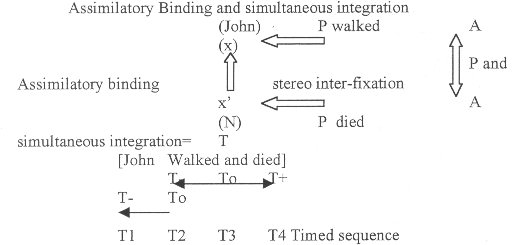 |
The stabilisation of Coordination is non peripheral. Four elements have been integrated and have been stabilised in three through the simultaneous integration of two Arguments which are related by an assimilatory binding. The element which is articulated in the simultaneous integration is the Argument x (Token: John) of the Predicate x' (Type). Two predicates share discontinuously, i.e, they are separated by an interfixed stereo connector, the same argument in a timed sequence.
In Phonology this simultaneous sharing of Argument effect can be seen when a Dextro integration and a Levo integration combine integrating their Argument simultaneously.2
| (24)a. | Subordination: Argument sharing |
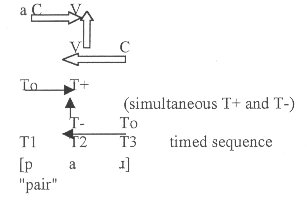 |
|
| (24)b. | Subordination: Cup element sharing |
 |
In (24) two monovalent Predicates are integrating and converging by sharing the same Argument in the sequence. Therefore, a four element component has been integrated into a three element one in a timed sequence or in a spatial sequence.
The contraction effect in (23) and (24) can be further seen when a monovalent and a bivalent Predicate share simultaneously one argument:
| (25) | Subordination: Argument Sharing producing contraction3 |
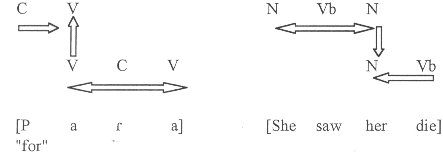 |
Subordination can be more complex when, for instance, two bivalent Predicates integrate simultaneously. Each Predicate has as argument the other predicate. I will refer to this as reciprocal embedding.
| (26) | |
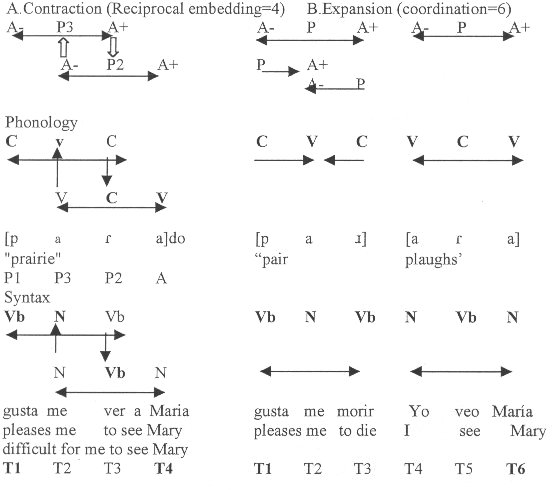 |
Stereo coherent minimal integrations with symmetry XYX are found in a neurphysiological level producing perception (Zigmond et al. 1999:ch.13). Reciprocal embedding can be found in visual recursive integration (Kay 1991).
| (27) | |
 |
In (26A), it can be seen that P3, the svarabhakti Vocoid, is the Argument A- of P2, the Consonant Rhotic, and that P2 is the Argument A+ of P3. Both arguments integrate simultaneously through a Token-type simultaneous substitution. This reciprocal embedding perhaps can be seen more clearly with a hierarchical representation using Categorial Phrasal nodes (García-Bellido 2000)4.
| (28) | |
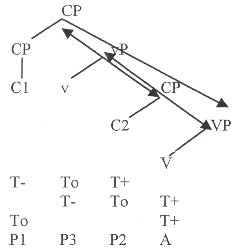 |
Reciprocal embedding is therefore an integrative regulatory mechanism which generates one single well defined percept.
1 See non-simultaneous assimilatory binding in (30a) below.
2 In non linear phonology (24) is a CVC whereby the Dextro integration constitutes the Rhyme, i.e the Nucleus+Coda and the Levo integration is the syllable, i.e. the Onset+Rhyme.
3 In minimalist syntax (Chomsky 1995) the accusative assignment of the NP her by the transitive verb see, occurs because the transitive verb has a small clause complement whose subject is caseless. Accusative case marking between Verb and NP in (25) is exceptionally a non symmetric c-commanding syntactic operation on the tree.
4 If reciprocal embedding is at work, then standard phrasal structure
(Chomsky 1995) or categorial grammar (Montague 1974) cannot account for it since a Node v cannot be the Predicate of its Argument
C2 while at the same time be the Argument of C2. V cannot be the argument of both C1 and C2.
Volumen 22 (2005) ISSN: 1139-8736 |